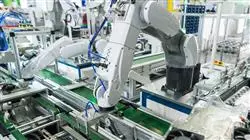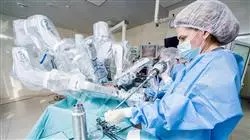University certificate
Scientific endorser

The world's largest faculty of engineering”
Introduction to the Program
Enter a constantly evolving technology sector and get up to date to achieve the best benefits for your digital business. Enroll now"
New technologies have driven Industry 4.0, but another major revolution has come from the pandemic caused by COVID-19. Drones, artificial intelligence, 3D printing have undergone a push that has revealed their great potential in many sectors. However, this situation has also served for the detection of digital deficiencies in other fields, which currently seek to develop using not only the tools and techniques themselves, but also favoring collaborative work. An ideal scenario for engineering professionals who are in high demand in an emerging sector. This 100% online program provides the latest information on the Internet of things, Robotics, Big Data or Quantum Computing. As could not be otherwise, it will feature innovative multimedia content, in which the latest technology applied to academic teaching has been used.

Today's progress has new technologies as a great ally, a digital transformation present from the educational bases to sectors such as aviation, automobiles, the arms industry, commerce and finance. All of this is geared towards the achievement of a true digital economy, in which the engineering professional plays a leading role thanks to their knowledge.
Change is rapid, accelerated by the pandemic caused by coronavirus, and initiatives from Open Source communities, Startups and public institutions are emerging.
The current scenario is completely favorable and forecasts predict a successful future for those who have decided to take this path and face the challenges posed by Industry 4.0. That is why TECH has gathered in this Professional Master's Degree a relevant teaching team in the engineering sector, whose main objective is to offer the most up-to-date knowledge in an area with great potential.
A program with a practical-theoretical approach, which provides graduates with a study in depth on virtual, augmented and mixed reality, industry 4.0 applied to sectors such as tourism, energy, construction or Smart Factory, or automation systems. The case studies provided by the specialists who teach this degree will provide students with a learning experience that is close to the reality they may encounter in their work performance in different areas.
Professionals, are also faced with a program that is taught exclusively online, in a convenient and flexible way. All they need is a computer, tablet or cell phone to connect to the virtual campus and access the complete syllabus of this program.
A program, without attendance or classes with fixed schedules, which also gives students the freedom to view or download the content of this Professional Master's Degree whenever they wish. Engineers are, therefore, facing an excellent opportunity to boost their career in a sector with a wide range of opportunities and also, with a, university education that is compatible with the most demanding responsibilities.
Give your profession a boost with this Professional Master's Degree and get the main tools and techniques to succeed in the Industry 4.0 field"
ThisProfessional master’s degree in Digital Transformation and Industry 4.0 contains the most complete and up-to-date program on the market. The most important features include:
- The development of case studies presented by experts in Digital Transformation and Industry 4.0.
- The graphic, schematic and eminently practical contents with which it is conceived provide technical and practical information on those disciplines that are essential for professional practice.
- Practical exercises where the self-assessment process can be carried out to improve learning.
- Its special emphasis on innovative methodologies
- Theoretical lessons, questions to the expert, debate forums on controversial topics, and individual reflection assignments
- Content that is accessible from any fixed or portable device with an Internet connection
This 100% online MBA will allow you to combine a university education with your professional work. You choose where and when to access"
The program includes in its teaching staff, professionals of the sector who pour into this specialization the experience of their work, in addition to recognized specialists from reference societies and prestigious universities.
The multimedia content, developed with the latest educational technology, will provide the professional with situated and contextual learning, i.e., a simulated environment that will provide immersive education programmed to learn in real situations.
This program is designed around Problem-Based Learning, whereby the professional must try to solve the different professional practice situations that arise during the course. For this purpose, students will be assisted by an innovative interactive video system created by renowned and experienced experts.
The completion of this university degree will place engineering professionals at the forefront of the latest developments in Industry 4.0"

Video summaries, detailed videos or specialized readings will allow you to delve into essential technologies in the tourism, agriculture or manufacturing sectors"
Why study at TECH?
TECH is the world’s largest online university. With an impressive catalog of more than 14,000 university programs available in 11 languages, it is positioned as a leader in employability, with a 99% job placement rate. In addition, it relies on an enormous faculty of more than 6,000 professors of the highest international renown.

Study at the world's largest online university and guarantee your professional success. The future starts at TECH”
The world’s best online university according to FORBES
The prestigious Forbes magazine, specialized in business and finance, has highlighted TECH as “the world's best online university” This is what they have recently stated in an article in their digital edition in which they echo the success story of this institution, “thanks to the academic offer it provides, the selection of its teaching staff, and an innovative learning method aimed at educating the professionals of the future”
A revolutionary study method, a cutting-edge faculty and a practical focus: the key to TECH's success.
The most complete study plans on the university scene
TECH offers the most complete study plans on the university scene, with syllabuses that cover fundamental concepts and, at the same time, the main scientific advances in their specific scientific areas. In addition, these programs are continuously being updated to guarantee students the academic vanguard and the most in-demand professional skills. In this way, the university's qualifications provide its graduates with a significant advantage to propel their careers to success.
TECH offers the most comprehensive and intensive study plans on the current university scene.
A world-class teaching staff
TECH's teaching staff is made up of more than 6,000 professors with the highest international recognition. Professors, researchers and top executives of multinational companies, including Isaiah Covington, performance coach of the Boston Celtics; Magda Romanska, principal investigator at Harvard MetaLAB; Ignacio Wistumba, chairman of the department of translational molecular pathology at MD Anderson Cancer Center; and D.W. Pine, creative director of TIME magazine, among others.
Internationally renowned experts, specialized in different branches of Health, Technology, Communication and Business, form part of the TECH faculty.
A unique learning method
TECH is the first university to use Relearning in all its programs. It is the best online learning methodology, accredited with international teaching quality certifications, provided by prestigious educational agencies. In addition, this disruptive educational model is complemented with the “Case Method”, thereby setting up a unique online teaching strategy. Innovative teaching resources are also implemented, including detailed videos, infographics and interactive summaries.
TECH combines Relearning and the Case Method in all its university programs to guarantee excellent theoretical and practical learning, studying whenever and wherever you want.
The world's largest online university
TECH is the world’s largest online university. We are the largest educational institution, with the best and widest online educational catalog, one hundred percent online and covering the vast majority of areas of knowledge. We offer a large selection of our own degrees and accredited online undergraduate and postgraduate degrees. In total, more than 14,000 university degrees, in eleven different languages, make us the largest educational largest in the world.
TECH has the world's most extensive catalog of academic and official programs, available in more than 11 languages.
Google Premier Partner
The American technology giant has awarded TECH the Google Google Premier Partner badge. This award, which is only available to 3% of the world's companies, highlights the efficient, flexible and tailored experience that this university provides to students. The recognition as a Google Premier Partner not only accredits the maximum rigor, performance and investment in TECH's digital infrastructures, but also places this university as one of the world's leading technology companies.
Google has positioned TECH in the top 3% of the world's most important technology companies by awarding it its Google Premier Partner badge.
The official online university of the NBA
TECH is the official online university of the NBA. Thanks to our agreement with the biggest league in basketball, we offer our students exclusive university programs, as well as a wide variety of educational resources focused on the business of the league and other areas of the sports industry. Each program is made up of a uniquely designed syllabus and features exceptional guest hosts: professionals with a distinguished sports background who will offer their expertise on the most relevant topics.
TECH has been selected by the NBA, the world's top basketball league, as its official online university.
The top-rated university by its students
Students have positioned TECH as the world's top-rated university on the main review websites, with a highest rating of 4.9 out of 5, obtained from more than 1,000 reviews. These results consolidate TECH as the benchmark university institution at an international level, reflecting the excellence and positive impact of its educational model.” reflecting the excellence and positive impact of its educational model.”
TECH is the world’s top-rated university by its students.
Leaders in employability
TECH has managed to become the leading university in employability. 99% of its students obtain jobs in the academic field they have studied, within one year of completing any of the university's programs. A similar number achieve immediate career enhancement. All this thanks to a study methodology that bases its effectiveness on the acquisition of practical skills, which are absolutely necessary for professional development.
99% of TECH graduates find a job within a year of completing their studies.
Professional Master's Degree in Digital Transformation and Industry 4.0
The advent of technology in digitization and virtualization has driven the creation and renewal of each of the stages of production processes. TECH Global University has created an educational program focused on the acquisition and updating of knowledge of the so-called fourth industrial revolution. Through our syllabus, professionals will be able to explore the possibilities offered by the Internet of Things (IoT) and cyber-physical systems in the creation of platforms oriented to the interconnection and communication between industrial devices. In addition, they will delve into everything related to quantum computing, artificial intelligence and the fundamental principles of Big Data. At the end of this Professional Master's Degree, they will have the necessary skills for the design, management and automation of factories and companies that make up the three economic sectors: Smart Farms (primary sector), Smart Factory (secondary sector) and Smart Cities (tertiary sector). In this way, they will not only be easily inserted into the labor market, but will also lead future changes in production, essential for increased competitiveness.
Professional Master's Degree in Digital Transformation and Industry 4.0
To contribute to the construction of new value chains that fit today's automation processes, it is essential to have a set of skills in technological management and innovation. Thanks to this TECH postgraduate program, the professional interested in these processes will master these skills, as they will be able to identify and develop models in industrial robotics, as well as PLC systems and feedback control systems. In addition, they will define prototypes of continuous monitoring and predictive and prescriptive maintenance. In a second level, engineers will address the current situation of technological markers and data exploitation, in order to dissect the new use cases derived from the contingent labor and production practices generated by covid. Based on these contents, the future experts in digitization of industries will also develop analytical and reflective skills around the era of absolute virtualization, paying special attention to the advantages and obstacles it poses.







